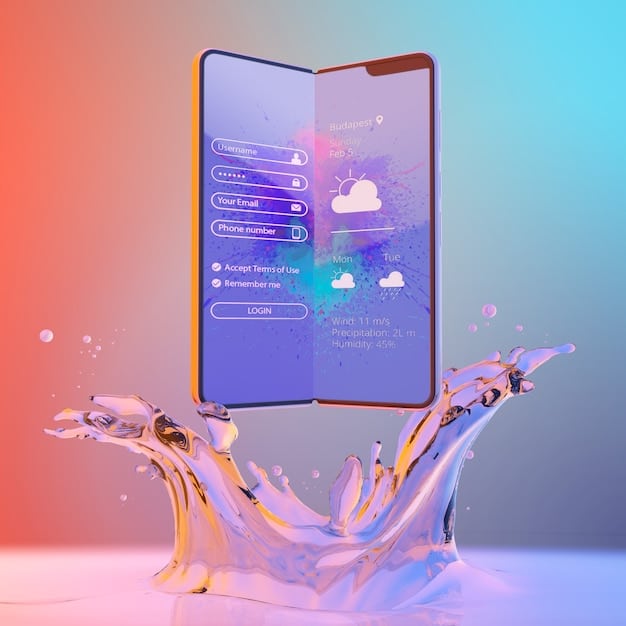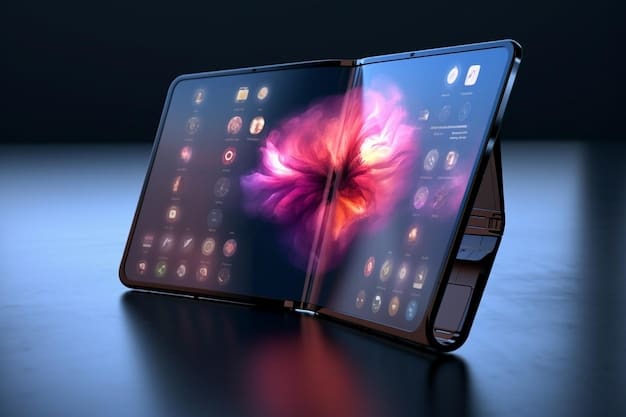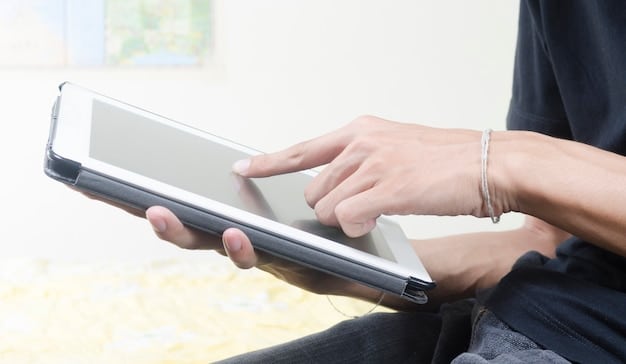$1200 Foldable Phone Review: Hype or Reality?

The $1200 foldable phone represents a significant leap in mobile technology, marrying innovative design with evolving functionality, yet its value proposition hinges on balancing cutting-edge features against ergonomic challenges, durability concerns, and premium pricing in a rapidly advancing market.
In the dynamic landscape of modern technology, every new iteration promises to redefine our digital lives. But when a device carries a price tag as hefty as $1200, it raises a critical question:
The Foldable Revolution: A Design Paradigm Shift
The advent of foldable smartphones ushered in a new era of mobile design, challenging the conventional slab form factor that has dominated the market for decades. This shift isn’t merely aesthetic; it promises a blend of compact portability and expansive screen real estate, adapting to various user needs throughout the day. The core appeal lies in the ability to carry a large-screen device that fits comfortably in a pocket.
Early adopters and tech enthusiasts have been captivated by the sheer ingenuity required to engineer a device that can bend and fold repeatedly without compromising its structural integrity or display quality. This fundamental innovation redefines expectations for what a smartphone can be, potentially merging the utility of a tablet with the convenience of a phone.
Engineering Marvel or Gimmick?
At its heart, a foldable phone is an engineering marvel. The hinge mechanism, the flexible display, and the internal component arrangement all represent significant advancements. However, the initial iterations often raised questions about whether these were truly practical innovations or merely expensive novelties.
- Flexible Display Technology: The development of ultra-thin, dynamic displays capable of bending thousands of times without degradation is a monumental achievement.
- Sophisticated Hinge Mechanisms: Designing a hinge that is both durable and seamless, allowing the screen to fold perfectly flat or remain at various angles, is complex.
- Component Miniaturization: Fitting powerful processors, cameras, and batteries into a compact, foldable chassis requires advanced design and manufacturing techniques.
Despite these innovations, the debate continues whether the benefits outweigh the inherent complexities and potential vulnerabilities of a foldable design. The initial excitement has transitioned into a more critical evaluation of long-term usability and durability, crucial for a premium device.
Real-World Versatility and Use Cases
Beyond the novelty, foldable phones offer genuine versatility. In its folded state, it provides a compact smartphone experience for quick tasks like checking notifications or making calls. Unfolded, it transforms into a larger display, ideal for media consumption, multitasking, or gaming, bridging the gap between phone and tablet.
This duality is where the $1200 foldable phone aims to justify its price. For professionals, it can serve as a miniature workstation; for multimedia enthusiasts, an immersive entertainment hub. The ability to prop the phone at various angles, often called “flex mode,” opens up new avenues for hands-free video calls, content creation, and even unique photography angles.
Performance and Specifications: Power Under the Flex
A premium price tag almost always implies top-tier performance, and the $1200 foldable phone is no exception. These devices typically house the latest generation processors, ample RAM, and high-capacity storage, ensuring a smooth and responsive user experience even with demanding applications. The focus here shifts from raw numbers to how these specifications translate into real-world usability on a unique form factor.
The challenge for manufacturers is optimizing software to seamlessly transition between the folded and unfolded states, ensuring apps resize correctly and productivity features are enhanced rather than hindered. A powerful chipset is essential to manage these complex transitions and maintain fluid operations.
Processor and Memory: The Core Engine
Expect to find flagship-level processing power in a device of this caliber. Most $1200 foldable phones are equipped with the most advanced mobile SoCs (System-on-Chip), akin to those found in conventional premium smartphones. This ensures lightning-fast app launches, seamless multitasking, and efficient handling of graphics-intensive games.
- Latest Generation Chipsets: Provides superior computational power and energy efficiency.
- Generous RAM: Typically 8GB to 12GB of RAM, enabling effortless switching between multiple open applications without slowdowns.
- Ample Storage: Standard configurations usually start at 256GB, offering plenty of space for apps, photos, and videos.
The robust hardware is necessary not just for current applications but also to future-proof the device to some extent, allowing it to handle increasingly demanding software and features as foldable technology matures. This foundational power is what enables the unique foldable experience.

Camera System: Capturing Moments, Folded or Unfolded
Photography is a major selling point for any smartphone, and foldable phones strive to deliver a premium camera experience despite the design constraints. Many leverage a multi-lens setup, offering versatility from ultra-wide shots to telephoto zoom. The unique form factor can even be utilized for creative photography.
For instance, some foldable phones allow users to use the main camera for selfies by partially unfolding the device, utilizing the larger, higher-quality sensors that would typically be reserved for rear-facing photography. This innovation adds significant value for content creators and casual photographers alike.
However, the internal space limitations can sometimes mean that while good, the camera systems might not always match the absolute best traditional slab phones in every single metric, especially in extreme low-light conditions or with advanced computational photography features. It’s a trade-off that buyers must consider.
Durability and Longevity: The Elephant in the Room
Perhaps the most significant hurdle for foldable phones, especially early models, has been durability. A display that bends inherently presents more vulnerabilities than a rigid one. While manufacturers have made significant strides, consumer confidence often lags behind technological advancements. For a $1200 device, longevity is paramount.
Concerns typically revolve around the display’s crease, its susceptibility to scratches, and the long-term reliability of the hinge mechanism. Early models were plagued by reports of screen damage and dust ingress. Addressing these issues demonstrably is crucial for mass adoption and justifying the premium price point.
The Crease: A Lingering Presence
Every foldable screen, to some extent, exhibits a crease where it folds. While newer generations have significantly reduced its prominence, it remains noticeable, especially when viewing the screen at certain angles or with specific content. For some users, it’s a minor aesthetic imperfection, but for others, it can be a distraction.
Manufacturers are continuously refining the display materials and hinge designs to minimize the crease, but a perfectly flat and invisible fold remains an engineering challenge. The impact of the crease on the user experience is subjective but worth considering for a device at this price point.
Screen Protection and Hinge Reliability
Unlike traditional glass screens, flexible displays often use ultra-thin glass (UTG) or specialized polymer layers that are more susceptible to scratches and punctures. Many manufacturers include pre-applied screen protectors or advice against direct stylus use to mitigate this risk.
- Improved UTG: Newer generations of ultra-thin glass offer enhanced durability, though still not as robust as rigid Gorilla Glass.
- Hinge Reinforcements: Manufacturers are employing more robust materials and designs for the hinges, often rated for hundreds of thousands of folds.
- Dust and Water Resistance: Progress has been made in formalizing IP ratings for foldables, though they often lag behind the water resistance of traditional flagships.
Despite advancements, care must be taken with a foldable phone. While they are far from fragile, they require a level of conscious handling that traditional smartphones might not. The peace of mind that comes with increased durability is a major factor for consumers investing over $1000.
Software Experience and Ecosystem Integration
Beyond the hardware, the software experience is critical for any smartphone, and even more so for foldables. Manufacturers must optimize the operating system and built-in applications to take full advantage of the unique form factor. A seamless transition between screen sizes and intelligent multitasking features are key indicators of a well-integrated software ecosystem.
The Android ecosystem, being the dominant OS for most foldables, has seen significant updates to better support large and dynamic screens. This includes features like improved split-screen multitasking, flexible windowing, and app continuity, where an app seamlessly transitions from the small cover screen to the larger main display upon unfolding.
Optimized User Interface and Multitasking
The appeal of a foldable phone lies in its ability to adapt. When unfolded, the larger canvas is perfect for productivity. Software optimizations allow for side-by-side app viewing, enabling users to drag and drop content between applications, run multiple apps in floating windows, or simply have a more expansive view of their content.
The challenge for developers is to create apps that look and function well on both the smaller cover screen and the larger inner display. While many popular apps have been optimized, some might still appear stretched or have UI elements that don’t scale perfectly, highlighting the ongoing evolution of the foldable app ecosystem. This optimization is crucial for maximizing the utility of the large screen.
For example, Flex Mode, where the phone is folded to an L-shape, allows for unique app interactions, such as video calls where the video is on the top screen and controls on the bottom, or camera apps where the viewfinder is on one half and controls on the other. These thoughtful software integrations enhance the hardware’s potential significantly.

Ecosystem Support and Future Updates
Investing in a $1200 foldable phone also means investing in a manufacturer’s commitment to supporting this new form factor. This includes timely software updates that not only deliver security patches but also introduce new features and further refine the foldable experience. A robust software update policy reassures users of ongoing improvements and longevity.
Moreover, the integration with other devices within a brand’s ecosystem, such as smartwatches, tablets, and headphones, plays a role. Features like quick pairing, seamless file transfer, and cross-device continuity enhance the overall user experience, making the foldable phone a central hub in a broader digital life. This holistic approach adds value beyond the device itself.
The Value Proposition: Is it Worth $1200?
Ultimately, the core question revolves around whether a $1200 foldable phone delivers sufficient value to justify its premium price tag. This isn’t a simple yes or no answer, as value is subjective and depends heavily on individual needs, usage patterns, and budget considerations. For some, the innovation and versatility will be an undeniable draw, while for others, the compromises or cost might be too high.
Comparing it to traditional flagships, the foldable phone often comes at a higher price point for similar core specifications (processor, camera). The premium is largely for the innovative form factor and the engineering required to achieve it. So, assessing its worth requires looking beyond raw specs and considering the unique user experience it offers.
Comparing Against Traditional Flagships
When stacked against conventional flagship smartphones in the $800-$1000 range, a $1200 foldable phone differentiates itself primarily through its bendable display. While traditional flagships often offer superior camera performance, longer battery life, or more robust water and dust resistance, the foldable provides a larger screen in a compact package, and a unique aesthetic.
Buyers must weigh whether the specific benefits of the foldable design—such as enhanced multitasking, improved media consumption, and the ‘cool factor’—outweigh the potential trade-offs in durability, camera parity, or battery life that sometimes accompany the form factor. The decision is often about prioritizing innovation over established reliability in some areas.
Target Audience and Future Outlook
Who is the $1200 foldable phone truly for? It tends to appeal to early adopters, tech enthusiasts, and professionals who can genuinely benefit from the larger screen for productivity or who appreciate cutting-edge technology. It’s less likely to be a mainstream device for the budget-conscious consumer, at least not yet.
- Tech Enthusiasts: Those who value innovation and want the latest and greatest technology.
- Productivity Users: Individuals who benefit from a larger screen for multitasking, document viewing, and content creation on the go.
- Multimedia Consumers: Users who enjoy an immersive viewing experience for movies, gaming, and browsing.
The future of foldable phones looks promising, with prices gradually coming down and durability improving with each generation. As manufacturing processes become more efficient and the technology matures, foldable phones could eventually become more accessible and mainstream. However, at $1200, it remains a luxury item targeting a specific niche.
User Experience and Daily Practicality
Beyond the technical specifications and debates over value, the true measure of any smartphone lies in its daily practicality and how it integrates into a user’s life. A $1200 foldable phone promises an elevated experience, but does it deliver a seamless and intuitive interaction day in, day out? The nuances of using a device that transforms can either be a boon or a minor inconvenience, depending on the implementation.
Considerations range from the weight and thickness in both folded and unfolded states to how well apps perform when transitioning between the screens. Battery life, often a concern for power-hungry devices with large displays, is another critical aspect that defines the daily experience. Ultimately, the best tech is often the one that fades into the background, simply working as expected.
Battery Life and Charging Speed
One of the persistent challenges for foldable phones has been battery life. Fitting large batteries into slender, foldable designs can be tricky. While modern foldables have improved, they sometimes don’t match the exceptional longevity of certain traditional flagships, especially when extensively using the larger, inner display.
Fast charging capabilities are often included to mitigate this, allowing quick top-ups. Wireless charging and reverse wireless charging are also becoming standard features, adding convenience. However, users considering a foldable phone for all-day heavy use might need to adjust their charging habits or invest in a power bank.
Portability and Ergonomics
The core promise of a foldable phone is portability: a tablet-sized screen that fits in a pocket. In its folded state, it’s undeniably more compact than an equivalent large-screen slab phone. However, the thickness can still be a factor for some, especially compared to the sleekness of traditional designs.
When unfolded, the ergonomics for single-handed use can vary. While the large screen is great for consumption, reaching all corners with one hand can be challenging. The weight distribution and the presence of the crease also play a role in how comfortable the device feels during extended use. These subtle aspects influence daily practicality.
The Verdict: Hype or Genuine Innovation?
After a thorough examination, it’s clear that the $1200 foldable phone stands at a crossroads between genuine innovation and lingering hype. It undeniably represents the bleeding edge of smartphone technology, offering a glimpse into the future of mobile devices. The engineering prowess alone is commendable, and the versatility it brings to various use cases is significant.
However, it’s also a technology in its relative infancy, still facing challenges in terms of widespread durability, complete software optimization across all apps, and, crucially, a price point that places it firmly in the premium, niche market. For many, a conventional flagship still offers a more balanced package of features, reliability, and value for daily use.
The “hype” aspect stems from the initial wow factor and the aspirational nature of owning such a cutting-edge device. The “genuine innovation” lies in the foundational technology that enables a transforming display, offering a fundamentally different way to interact with a smartphone. While it lives up to the hype in terms of technological achievement and certain unique benefits, it doesn’t necessarily mean it’s the perfect device for everyone.
| Key Feature | Brief Description |
|---|---|
| 🔄 Foldable Design | Transforms from compact phone to large tablet screen. |
| 🚀 Top-Tier Performance | Equipped with latest processors and ample RAM for smooth operation. |
| 🛡️ Evolving Durability | Significant improvements in screen and hinge resilience, though still a consideration. |
| 💡 Software Optimization | UI adapted for seamless transitions and enhanced multitasking. |
Frequently Asked Questions About Foldable Phones
▼
The primary advantages are its versatile form factor, offering a large display for productivity and media consumption that folds into a compact, pocketable device. They also feature cutting-edge design and often top-tier performance specifications, making them appealing to tech enthusiasts seeking innovation and a unique user experience.
▼
Modern foldable phone screens have significantly improved in durability compared to early models, using stronger ultra-thin glass (UTG) and more robust hinge mechanisms. While they are designed for daily use and undergo extensive testing, they generally require slightly more care than traditional glass slab phones and may still exhibit subtle creases.
▼
Battery life on foldable phones has improved, but due to their unique design and the power demands of larger, flexible displays, it can sometimes be less than that of standard bulky slab smartphones with massive batteries. Performance varies greatly by model and usage, especially when consistently using the larger inner screen.
▼
The $1200 price tag reflects the advanced research, development, and manufacturing complexities of foldable technology. While it’s a significant investment, it is justified for users who prioritize bleeding-edge innovation, unique form factors, and the specific productivity and entertainment benefits offered by a large, adaptable screen.
▼
Future foldable phones are expected to feature less noticeable display creases, even greater durability with enhanced screen and hinge technologies, improved water and dust resistance, and better battery optimization. We may also see more diverse form factors, further integration of styluses, and more refined software experiences leveraging the unique design.
Conclusion
In conclusion, the $1200 foldable phone unequivocally lives up to the hype in terms of its technological marvel and the sheer innovation it represents. It offers a glimpse into a future where our devices are more adaptable and versatile than ever before. While the premium price and lingering questions around long-term durability and the visible crease remain valid considerations, the user experience for those who prioritize its unique features is undeniably compelling. As the technology continues to mature, and prices gradually become more accessible, foldable phones are poised to transition from aspirational gadgets to mainstream contenders, truly reshaping our interaction with mobile technology. For now, it’s a powerful statement of what’s possible, a device that captivates and challenges the status quo.





